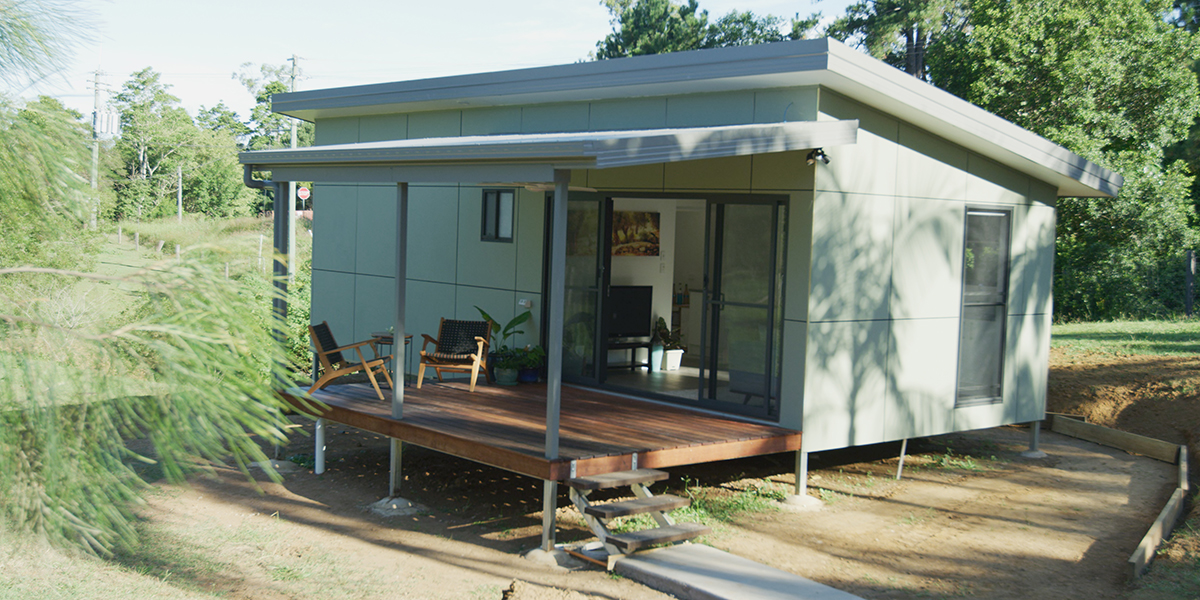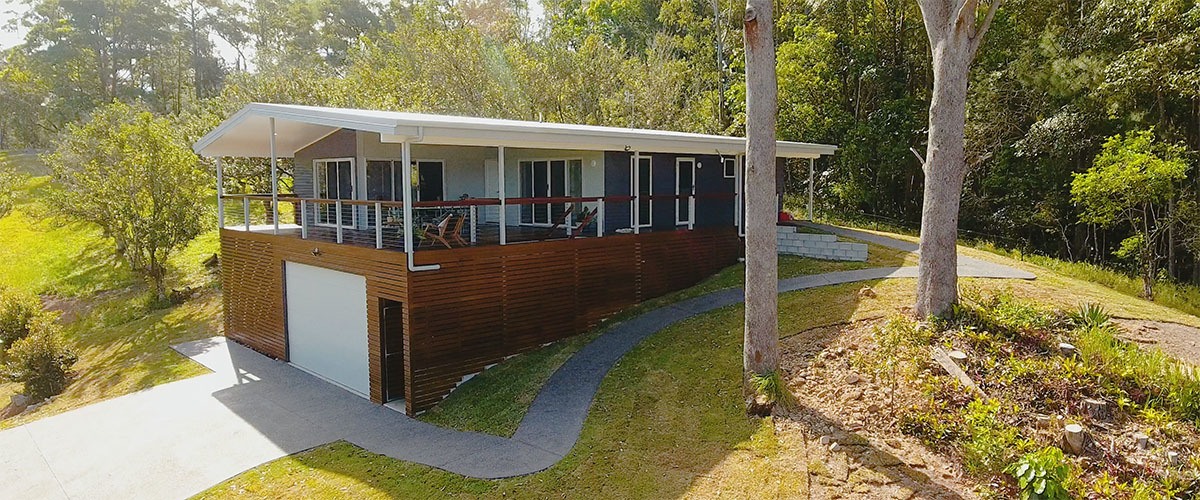Considering a granny flat or duplex on your Sunshine Coast property?
Looking for information on building an additional residence on your property?
What is a secondary dwelling?
Under the Sunshine Coast Planning Scheme 2014, a “secondary dwelling” is included in the use definition of a dwelling house, and is defined in the planning scheme as:
“A dwelling used in conjunction with, and subordinate to, a dwelling house on the same lot. A secondary dwelling may be constructed under a dwelling house, be attached to a dwelling house or be freestanding.”
A “dwelling” is also defined in the planning scheme and means a building or part of a building used or capable of being used as a self-contained residence that must include food preparation facilities, a bath or shower, a toilet and wash basin and clothes washing facilities.
For the purposes of the planning scheme, the addition of a secondary dwelling on the same lot as an existing dwelling house is considered to be a material change of use.
A secondary dwelling (commonly known as a ‘granny flat’ or ‘annexed unit’) is intended to be small in scale and clearly ancillary to the dwelling house on the same lot. Another key point of difference is that a secondary dwelling cannot be separately titled.
Whilst being a self-contained residence, a secondary dwelling is not the same as a dual occupancy (e.g. duplex).
What is dual occupancy?
A dual occupancy is a term for two dwellings on a single lot. In accordance with the Queensland Planning Provisions, under the Sunshine Coast Planning Scheme 2014, a dual occupancy is defined as:
“Premises containing two dwellings on one lot (whether or not attached) for separate households.”
A common example of a dual occupancy is a duplex.
📋 Dual Occupancy Information Sheet [421KB]
📋 Dual Occupancy Code - Checklist [160KB]
📋 Dual occupancy in the Low density residential zone [48KB]
Here are some handy links to council information about 'Dual Occupancy' on the Sunshine Coast.
Please note this is not a complete list of codes that may apply to your plans.
For further information please refer to the Sunshine Coast Council website.
ℹ️ Sunshine Coast Council Development Applications Advice
📷 Supplied by Aussie Tiny Houses
A granny flat could 'unlock wealth' in your backyard and help with housing affordability
Date: 4 February 2021 | Author: Kat Donaghey | Source: Sunshine Coast News
As house prices and rents soar on the Sunshine Coast, a solution to affordability could be in your backyard.
Granny flats are being touted as one way to increase the number of dwellings and provide more affordable housing as Coast families struggle to find somewhere to live.
Building granny flats could help the Coast reach a target set by the state government for 60 per cent of new housing (53,700 dwellings) built as ‘infill’ development by 2041 – ie. built on existing urban land.
That equates to more than 2000 infill dwellings, such as apartments and townhouses, going up on the Coast each year.
This ‘infill’ target is expected to feature heavily in discussions as the Sunshine Coast Council embarks on drawing up a new town plan.
Do you have an opinion to share? Sunshine Coast News will soon launch a Letters to the Editor section. Feel free to submit via: [email protected]
Urban planners such as Project Urban are urging people to consider how they could “unlock the wealth” in their backyard and are offering free town planning property assessments.
As well as building a granny flat, Project Urban suggested options for backyard infill include sub-dividing your block into two, demolishing a house to build a duplex or townhouses or adding a secondary dwelling to the side or rear of your home.

A weekender granny flat at Hunchy. Picture: The Shed House
Granny flats, which are classed as secondary dwellings, are perhaps the easiest option and can range in price from $12,000 pods to $120,000 custom-designed homes.
However under the existing Sunshine Coast town plan, granny flats can only be used as accommodation for people from the same household as the main dwelling.
This means that collectively, people living in the granny flat and the main house must “have the common intention to live together on a long-term basis and make common provision for food or other essentials for living”.
Help keep independent and fair Sunshine Coast news coming by subscribing to our free daily news feed. All it requires is your name and email. See SUBSCRIBE at the top of this article
A granny flat must also be built on a block of minimum 600sqm and has to be within 20m of the main dwelling, even in rural areas.
Gary Cox, from The Shed House, said granny flats were soaring in popularity but some of the council’s rules were too restrictive.
Mr Cox urged the council to consider changing the restrictions in the new town plan which would help meet infill targets and provide more affordable housing.
He said the current requirement to build the granny flat within 20m of the principal dwelling – even on large rural blocks – in the Sunshine Coast Council footprint was not ideal. The Noosa Shire Council recently abolished a similar rule.

A granny flat on a sloping block in Noosa where they do not have to be within 20m of the main house.
Picture: The Shed House
“When people ring up to enquire about a granny flat, the first thing I ask them is ‘Are you happy for it to be within 20m’ because most people don’t know that’s the case,” Mr Cox said.
“Some people don’t mind the 20m rule because they have elderly parents they are caring for but then others want more space and want the house to be further away; they don’t want to be living on top of each other.”
Mr Cox said many people were also unaware that the rules were designed to prevent a granny flat being rented out to tenants or promoted on sites like Airbnb.
“A lot of people put them in to rent out as secondary dwellings and they do that without us knowing,” he said.
Mr Cox said lifting the 20m rules would in itself encourage more granny flat development but also changing the definition of a household would create more affordable housing.
“People with the right size backyard could put in a secondary dwelling to create more affordable housing but the rules as they are don’t allow it,” he said.
However Sunshine Coast councillor Terry Landsberg said the popularity of granny flats was leading to increased complaints from neighbours about dwellings butting up near their fences.
“There is real concern because we’re seeing more of these enquiries and complaints lodged,” he said.
“In some cases the granny flat impacts on the neighbour’s privacy and visual amenity.”
Cr Landsberg said the current rules were designed to ensure people used granny flats for their intention – to house a family member – but he said people were building them as rentals instead.
Cr Landsberg said it was important to protect “character areas” such as Moffat Beach where granny flats have to be smaller (42sqm floor space as opposed to 60 sqm elsewhere or 90sqm in rural areas) and cannot exceed 4m in height.
Cr Landsberg said infill development was a “sensitive issue” that would have to balance protecting the Coast’s lifestyle and amenity while accommodating the projected growth to a population of 500,000 by 2041.
“This will be part of the next stage (of developing a new planning scheme) — looking at infill targets set by the state government.”
Read full article here.
Council to adopt changes to second dwelling regulations
The Sunshine Coast Council will be adopting the proposed changes to the Sunshine Coast Planning Scheme 2014 that involve the regulations around secondary dwellings.
The changes are to be implemented at some stage this year.
The new regulations state that secondary dwellings must be located, designed and constructed to have an association with the primary dwelling, and be small in size, such that the secondary dwelling is ancillary to the primary dwelling, and provides housing for a small household.
With the new regulations, a secondary dwelling:
• Must have maximum floor area of 90m2 in a Rural or Rural residential zone or 60m2 in any other zone. In Caloundra Local area, the maximum gross floor area is 45m2 and height must not exceed 4 metres.
• Where freestanding must be located within 20 metres of the primary dwelling
In an urban zone, the secondary dwelling must be located on a lot which:
• Has a minimum area of 600m2
• Is regular in shape (i.e. square or rectangular) or, if not regular in shape, is able to accommodate a square or rectangle of at least 400m2 in area within the lot.
Secondary and primary dwellings must share:
• A single common water connection and meter and waste-water connection/system
• Street number and letterbox
• Vehicle access driveway and access point
It is recommended to get your applications in early if you wish to comply with the previous regulations.
The purpose of these amendments is to:
1. amend the zones, overlays and/or precincts relating to a number of specific sites in the localities of Buderim, Chevallum, Dicky Beach, Eerwah Vale, Golden Beach, Kenilworth, Kunda Park, Landsborough, Little Mountain, Maleny, Mount Coolum, Pelican Waters, Witta, and Woombye;
2. amend the zone and the Height of buildings and structures overlay for a number of specific sites relating to Educational establishments, Retirement facilities and Residential care facilities, in locations across the planning scheme area;
3. reduce the number of building height increments in the Height of buildings and structures overlay, which applies to the entire planning scheme area, which will result in minor changes to the applicable building height limit for certain sites; and
4. address other operational matters to improve the clarity and efficiency of the planning scheme.
The proposed amendment was published on 28 July 2018, and the public consultation period the proposed amendment to the Sunshine Coast Planning Scheme 2014 has now ended.
View the proposed amendment here. | ℹ️ Help with the Planning Scheme



.png)
.jpg)
